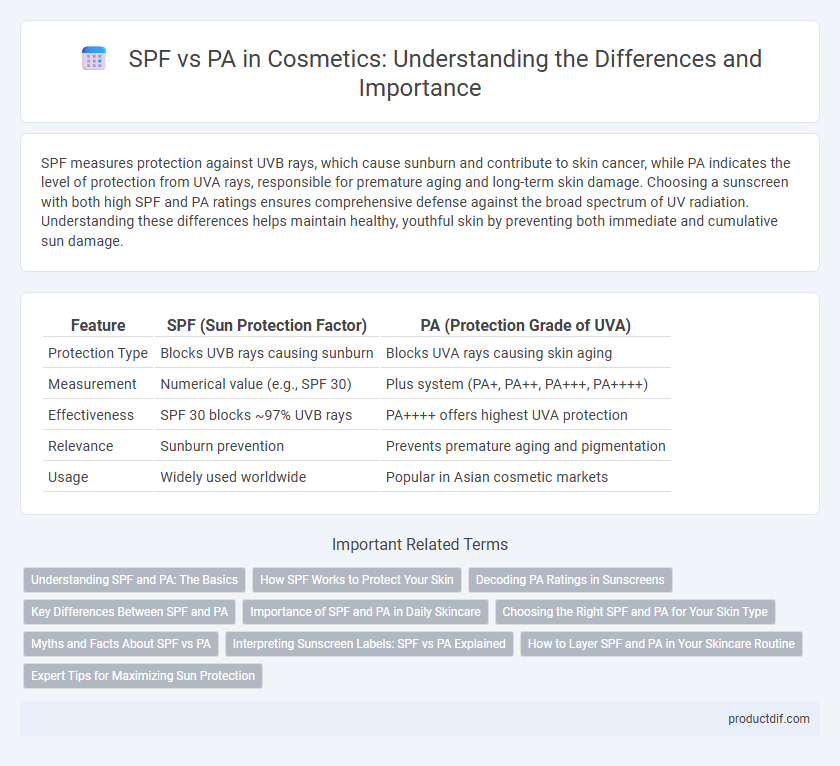SPF measures protection against UVB rays, which cause sunburn and contribute to skin cancer, while PA indicates the level of protection from UVA rays, responsible for premature aging and long-term skin damage. Choosing a sunscreen with both high SPF and PA ratings ensures comprehensive defense against the broad spectrum of UV radiation. Understanding these differences helps maintain healthy, youthful skin by preventing both immediate and cumulative sun damage.
Table of Comparison
| Feature | SPF (Sun Protection Factor) | PA (Protection Grade of UVA) |
|---|---|---|
| Protection Type | Blocks UVB rays causing sunburn | Blocks UVA rays causing skin aging |
| Measurement | Numerical value (e.g., SPF 30) | Plus system (PA+, PA++, PA+++, PA++++) |
| Effectiveness | SPF 30 blocks ~97% UVB rays | PA++++ offers highest UVA protection |
| Relevance | Sunburn prevention | Prevents premature aging and pigmentation |
| Usage | Widely used worldwide | Popular in Asian cosmetic markets |
Understanding SPF and PA: The Basics
SPF (Sun Protection Factor) measures the level of protection against UVB rays responsible for sunburn, indicating how long skin can be exposed before burning. PA (Protection Grade of UVA) rates the defense against UVA rays, which penetrate deeper and cause aging and long-term skin damage, using plus signs (PA+, PA++, PA+++). Understanding both SPF and PA is essential for selecting sunscreens that provide comprehensive protection from harmful ultraviolet radiation.
How SPF Works to Protect Your Skin
SPF, or Sun Protection Factor, measures a sunscreen's ability to block UVB rays responsible for sunburn and skin damage. Higher SPF values indicate greater protection by absorbing or reflecting UVB radiation before it penetrates the skin. Effective SPF products reduce the risk of DNA damage and skin aging by minimizing exposure to harmful UVB rays.
Decoding PA Ratings in Sunscreens
PA ratings in sunscreens indicate the level of protection against UVA rays, with PA+ offering some UVA protection and PA++++ representing extremely high protection. SPF primarily measures UVB protection responsible for sunburn, while PA ratings target UVA-induced skin aging and long-term damage. Understanding PA ratings helps consumers choose products that provide comprehensive defense against both UVA and UVB radiation for healthier skin.
Key Differences Between SPF and PA
SPF (Sun Protection Factor) measures protection against UVB rays responsible for sunburn, while PA (Protection Grade of UVA) indicates defense against UVA rays that cause skin aging and long-term damage. SPF values are numerical, such as SPF 30, representing the time you can stay in the sun without burning, whereas PA ratings use plus signs (PA+, PA++, PA+++) to denote increasing levels of UVA protection. Understanding both SPF and PA is essential for comprehensive sunscreen effectiveness and broader skin care against daily sun exposure.
Importance of SPF and PA in Daily Skincare
SPF (Sun Protection Factor) measures protection against UVB rays, which cause sunburn and contribute to skin cancer, while PA (Protection Grade of UVA) indicates defense against UVA rays that lead to premature aging and skin damage. Incorporating both SPF and PA in daily skincare ensures comprehensive protection from harmful ultraviolet radiation, preventing long-term skin issues and maintaining a youthful complexion. Regular use of broad-spectrum products with high SPF and PA ratings is crucial for effective sun defense and overall skin health.
Choosing the Right SPF and PA for Your Skin Type
Selecting the appropriate SPF (Sun Protection Factor) depends on your skin type and daily sun exposure, with SPF 30 offering broad protection for most skin tones while higher SPF levels like 50 suit fair or sensitive skin. PA ratings measure UVA protection strength; PA+ suits minimal sun exposure, whereas PA+++ or PA++++ is ideal for prolonged outdoor activities or for those with UV-sensitive skin. Understanding the balance between SPF and PA ensures effective defense against both UVB and UVA rays, reducing the risk of sunburn, premature aging, and skin cancer.
Myths and Facts About SPF vs PA
SPF (Sun Protection Factor) primarily measures protection against UVB rays responsible for sunburn, while PA rating indicates protection against UVA rays that contribute to skin aging and long-term damage. A common myth is that high SPF alone provides complete sun protection, but without a PA rating, UVA protection may be insufficient. Effective sunscreen requires both a high SPF and a strong PA rating to shield skin from the full spectrum of sun damage.
Interpreting Sunscreen Labels: SPF vs PA Explained
Understanding sunscreen labels involves interpreting SPF (Sun Protection Factor) and PA (Protection Grade of UVA) ratings, which indicate protection against UVB and UVA rays respectively. SPF measures how well a product shields skin from UVB-induced sunburn, while PA uses plus signs (+ to ++++) to denote the level of UVA defense, crucial for preventing skin aging and long-term damage. Selecting a sunscreen with both high SPF and PA values ensures comprehensive protection against harmful ultraviolet radiation.
How to Layer SPF and PA in Your Skincare Routine
SPF measures protection against UVB rays causing sunburn, while PA indicates defense against UVA rays responsible for aging. Layer your skincare by first applying a broad-spectrum PA++ or higher sunscreen after moisturizer, allowing absorption before reapplying SPF every two hours outdoors. Combining SPF and PA ensures comprehensive protection, enhancing skin's defense against both sunburn and photoaging.
Expert Tips for Maximizing Sun Protection
SPF measures protection against UVB rays, preventing sunburn, while PA indicates protection from UVA rays, which cause deeper skin damage and aging. Experts recommend using broad-spectrum sunscreens labeled with both high SPF (30 or above) and PA ratings (PA++ or higher) to ensure comprehensive defense. Reapplying every two hours and after swimming or sweating is essential for maintaining effective sun protection throughout the day.
SPF vs PA Infographic

 productdif.com
productdif.com